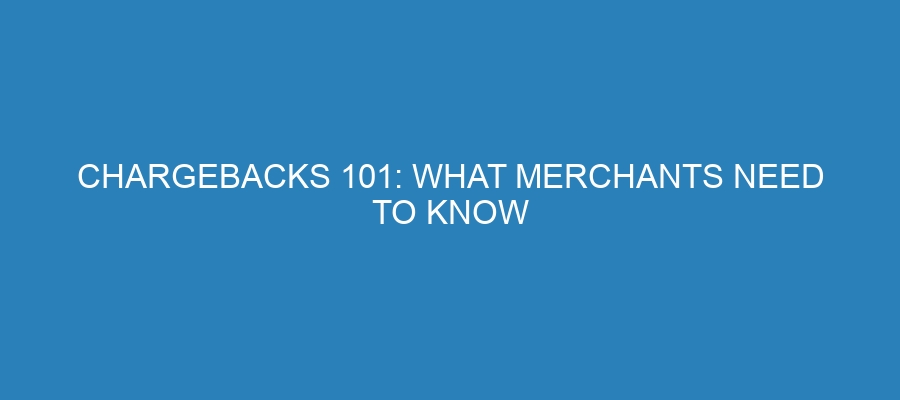In the dynamic world of e-commerce, chargebacks are a hot topic that can strike fear into the hearts of merchants everywhere. But what exactly are chargebacks, and why should you, as a merchant, be concerned? This article demystifies chargebacks, offering crucial insights into their implications, reasons for occurrence, and how to effectively manage them. Buckle up, because understanding chargebacks could save your business from potential financial turmoil!
What are Chargebacks?
At its core, a chargeback is a transaction reversal initiated by the cardholder’s bank. This usually happens when a customer disputes a charge on their card statement. Picture this: a customer doesn’t recognize a charge, they claim fraud, and suddenly you’re faced with a financial headache. Chargebacks can be attributed to several reasons, including:
- Fraudulent Transactions: Unauthorized transactions made with stolen card information.
- Unrecognized Charges: Customers not recalling the purchase, leading them to believe it was fraudulent.
- Goods Not Received: Customers claim that their order never arrived.
- Product Quality Issues: Complaints about the product being defective or not as described.
The Impact of Chargebacks
Chargebacks don’t just affect your bank balance; they can also significantly impact your business operations and reputation. The repercussions include:
- Financial Loss: Besides losing the sale amount, merchants often incur additional fees for each chargeback processed.
- Increased Processing Rates: High chargeback rates can lead to merchants being categorized as high-risk, causing transaction fees to skyrocket.
- merchant account Termination: If chargebacks become excessive, payment processors may decide to terminate your merchant account, making it nearly impossible to process payments.
With the stakes this high, understanding chargebacks is critical in today’s customer-centric market.
How to Prevent Chargebacks
While chargebacks are often unavoidable, there are proactive measures you can take to minimize their occurrence.
-
Transparent Messaging: Make sure your website communicates all necessary information about the products, shipping times, and return policies. Clear messaging reduces confusion for customers and can help prevent disputes.
-
Customer Support: Providing prompt and effective customer support can resolve issues before customers resort to filing chargebacks. Encourage customers to reach out directly if they have concerns.
-
Order Confirmation Emails: Sending email confirmations with purchase details helps customers keep track of what they’ve bought, reducing the chances they’ll dispute unknown charges.
-
Fraud Prevention Tools: Investing in tools and services that help detect and prevent fraud (like those provided by PaymentCloud) can save you time and money in the long run.
-
Maintain High-Quality Products: While this may seem obvious, consistently delivering quality products minimizes dissatisfaction and reduces chargebacks related to product quality issues.
Handling Chargebacks Once They Occur
Despite all preventative measures, chargebacks can still occur. Here’s how to handle them effectively:
-
Document Everything: Keep meticulous records of all transactions, communications, and shipping details. This documentation is crucial if you choose to dispute a chargeback.
-
Respond Quickly: As soon as you receive a chargeback notification, act promptly. There’s usually a limited timeframe for you to respond and present your case.
-
Analyze Patterns: Identifying patterns in chargebacks can help you understand potential flaws in your business operation. Are certain products frequently disputed? Is there a consistent customer demographic responsible for most chargebacks?
-
Engage with Your Payment Processor: Your payment processor can provide assistance and guidance. Understanding their policies regarding chargebacks can also help you navigate the situation more effectively.
FAQs About Chargebacks
Q: How long does a customer have to file a chargeback?
A: Typically, customers have 60 to 120 days from the transaction date to file a chargeback, depending on the card issuer’s policies.
Q: Can chargebacks be disputed?
A: Yes, merchants can dispute a chargeback by providing evidence to contest the customer’s claim. The outcome depends on the quality of the provided evidence.
Q: Are all chargebacks filed for fraudulent reasons?
A: No, chargebacks can stem from various reasons, including misunderstanding of a transaction, dissatisfaction with a product, or even failed delivery.
Q: Can chargebacks affect my credit score?
A: Chargebacks don’t directly impact your personal or business credit score, but they can lead to issues with your merchant account, which could indirectly affect your credit standing.
Q: What are the potential fees associated with chargebacks?
A: Merchants can incur chargeback fees ranging from $20 to $100 per incident, depending on the payment processor.
Conclusion
Chargebacks are an inevitable part of the merchant landscape, and while they can pose a significant threat to your bottom line, being prepared and informed can make a world of difference. By implementing proactive strategies and maintaining open communication with your customers, you can minimize their occurrence and impact.
For those looking to streamline their merchant processing and gain further insights into chargeback management, consider reaching out to Payminate.com today. Their expertise can guide you through the complexities of merchant processing and help protect your business from potential financial setbacks. Don’t let chargebacks catch you off guard; take control of your financial fate today!

